This badminton racket maintenance article is long overdue. As a tournament stringer, I see so many different badminton rackets. At tournaments, the pressure is on. There isn’t the time to spend on preparation of a racket. Generally, there’s just about enough time to restring the racket and possibly add a logo onto the strings. This is expected for sponsored players but is still optional.
There are three requirements to ensure your racket is playing its best:
- The choice and life of the string
- The grip
- Grommets
I have written articles and recorded videos on string choice and string tension. I recommend you read/watch these when you can. Also check out my dedicated stringing page. Some players will use their beloved racket until a string breaks before having it restrung. That’s fine for beginners, social and league players who are currently at the lower end of the skill spectrum.
For highly skilled badminton players, especially those playing in the leagues, there should be greater consideration for having your racket restrung frequently. Why? Over time, strings lose some of their elasticity. String tension drops and therefore the racket is not playing anywhere near the tension asked for.
Badminton strings will lose around 10% in tension within the first 48 hours following stringing, and then continue to diminish at different rates, depending on the string. This is what’s known as string creep. It’s common for players to enjoy playing with their racket more just before string breakage i.e. when tension is at its lowest.
I’ve heard various “rules of thumb” regarding how often a racket should be restrung. Take these as guidelines and go off your instinct. A common “rule” is to consider how many times per week you play. If you play twice a week then have your racket restrung twice a year. I’ve heard this “rule” from so many different places. However, there’s a difference between a player who is on court for one hour, twice a week and a player who plays for three hours, twice a week. Add into this, playing standards, intensity of play plus other variables and you can see the “rule” is not so good.
My advice is to use a professional stringer and discuss with them how often you should have your racket restrung. Whilst you may think the stringer is going to sell you lots more restrings in a year, they wish to retain your custom so it’s not in their interest to upset you. Work out your budget and then see if you can agree a program with your stringer.
Poor Grips Can Lead To Injury
When stringing at the All Englands, I see a range of grip types. What the players have in common is that they will replace grips often to ensure they do not play with a worn out grip.
For social and league players, the story is so different. When I visit clubs I see lots of rackets with poorly fitting grips. I also see a high percentage of grips that are clearly past their best and some are extremely dangerous.
With grip selection, this is personal. I have tested hundreds of grips over the years, all of which were good in their own way. All of the racket manufacturers offer a range of grips so there is no excuse for not finding a suitable grip for you.
How often should you change your grip?
This depends on a number of factors.
If you sweat a lot then you should change your grips more often. Sweaty grips take time to dry out and they smell. I’ve had to change many grips that were rancid. The sweat had soaked through the grip and was wetting the wooden handle. Over time this could damage the handle of the racket.
For players with sweaty hands, towelling is considered the best by many. However, for some, they don’t like the feel or find a new grip too slippery. Players use grip powder or resin pads which adds a layer of “glue” or dryness onto the grip depending which is used.
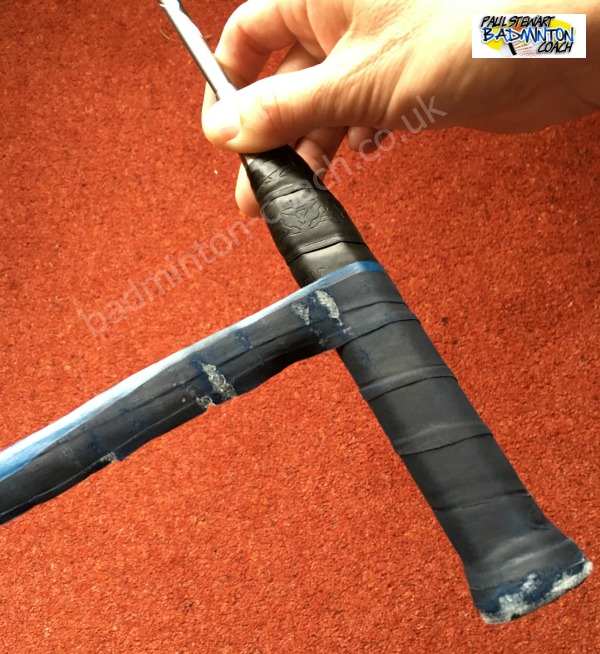
If towel grip doesn’t feel right, then look for a grip that offers high absorbency. A common sense approach is required to changing the grip and will depend on how often you play, and how sweaty your hands are.
If you have relatively dry hands like me, then a tacky grip may prove to be the answer. These grips have a limited life and will not remain tacky for too long, but the feeling on them is worth it. I find a tacky grip lasts me around 2-3 weeks and I pick up a racket every day. If you play once a week then a grip like this can last for a couple of months.
If you wear a ring on your racket hand, then you may find the ring is rubbing against the grip, creating a hole. In situations like this you choose whether to remove your ring before play or change your grip more often. Worn areas can sometimes spread. This in turn may lead to rubbing in other areas and you leaving court with a blister.
Pay Attention To The Grommets In Your Racket
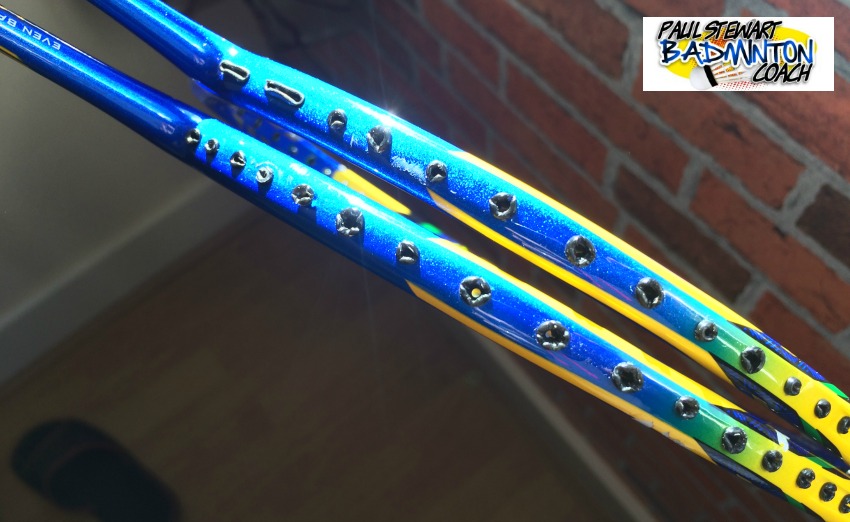
As a professional stringer, I am amazed at the state of grommets in players rackets. During the All Englands, we are under pressure to restring rackets quickly so that the players can collect and have them ready for action. It is expected that we undertake minimal grommet repair during peak times. However, towards the latter stages of the tournament we often re-grommet an entire racket.
Grommets provide protection for a string, otherwise the string will press against the frame. A simple miss-hit can result in severe pressure being placed on the string, pushing into the frame, which in turn slices through the string, resulting in breakage.
With older rackets, I see more areas of concern with grommets. Rather than a simple split grommet, which occurs on the inside of the frame, grommets can wear on the outside of the frame. This can be a result of putting in/taking out a racket which catches a zip in a bag. Over time this damages the string and can lead to breakage. Additionally, scraping the shuttle off the floor rubs both the string and grommet. String life is shorted considerably by this method of picking up the shuttle. A high percentage of newer frames have shallow grooves for the string to sit in. When taking a side-on view of the racket, you can see the string is protruding from the frame. The string is therefore scraping the floor when a shuttle is collected.
Strings cut grooves into grommets when they are threaded through a racket. These grooves wear down over time. It is important that there is a clear distance from the frame to the lowest part of the groove. If the string is resting on the outside of the frame, there is more pressure on the grommet hole. This in turn can lead to erosion of the hole, continuing to weaken the frame until the string pushes through the frame. This damage results in either a frame repair or binning of the racket and a new purchase.
By replacing worn grommets frequently, this prolongs the life of the string and the frame itself. Professional badminton stringers know how important this is. A simple frame inspection will tell them how much work needs to be done and you should be prepared to pay for the replacement of these grommets.

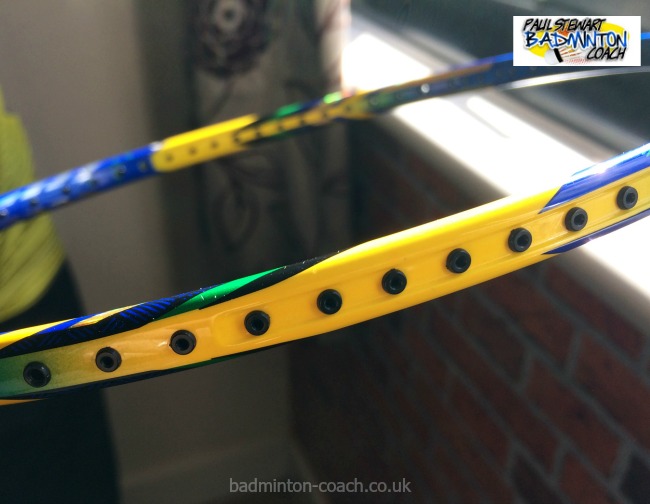
A full grommet replacement can take from 15-30 minutes. You should therefore be prepared to compensate the stringer for their time, replacement materials and expertise. Whilst the job isn’t always difficult, the older rackets, especially those with hollow metal heads can take up to one hour to complete.
There are certain rackets that require specific grommet sizes or grommet strips. These have to be purchased by professional stringers. The cost of these varies and can depend on whether there are stocks in a country or whether the stringer must import them. Grommet strips can be very good in respect of protecting the frame but it’s a pain when one grommet has split and a full strip replacement is required. It’s a bigger pest if a stringer has to purchase an entire set to obtain one strip. They may charge you for the set and provide you with the non-used grommets in the set for future use.

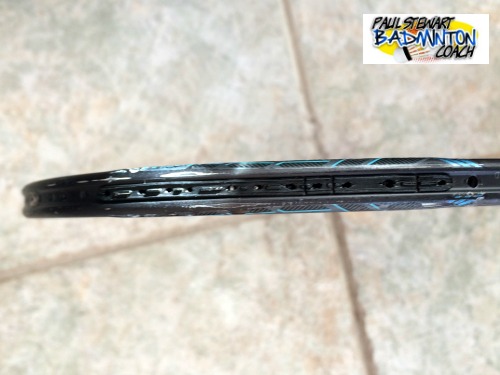
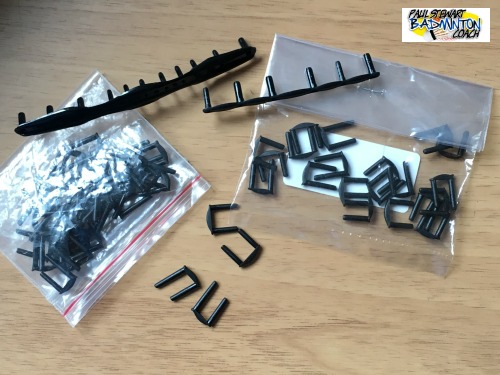
Some stringers prolong the life of a grommet by turning it a quarter of a turn. What this does is provide a fresh, unused side of the grommet. It can save money and time. We do this at the All Englands when time is precious. I prefer to change the grommet when the groove is too low as I like the racket to look tidy too. But turning the grommet is practical, it just doesn’t look as good. The grommet continues to perform the same function. In the photos below you can see how ugly turned grommets can be.
Some rackets use special shaped U-grommets. These can be found towards the throat of the racket. All frames, except very old rackets, will have them installed as part of the centre grommet on each side. The U-grommet provides a bridge from the first throat grommet to the second. This gives the string a smooth channel to sit in which helps with stability of the string.
When stringing high tension, depending on the frame, I add a couple of extra U-grommets to prolong this strengthening. It’s not required so much if the racket is restrung at a low tension. I have also tested customising grommet strips or adding special shaped grommets if the holes in the frame show any signs of stress or could stress because of the high tension. This is to prevent the wear and tear on the frame or to prolong the life of the frame when there are first signs of stress around a hole.
Most players will not check the frame as this will require removing the grommets. If you have your rackets restrung at high tension (26lbs or above) then please ask your stringer to check the frame carefully and test in the key areas. The stringer should know what this means.
Summary
So now you should understand more about badminton racket maintenance so it can play at its optimum for you. It’s always the little things that make the difference. Regular changing of grommets, changing grip, having your racket restrung ensures you get the best out of your racket, irrespective of the price you pay.
As your standard of play improves, you should pay more attention to these key areas. The chances of breaking a string are reduced although cannot be eliminated. However, at least you have the confidence in knowing that you have taken the necessary steps to prevent a broken string, and the racket should feel good in your hand with the fresh grip. It’s better to do this than arrive on court with a rag of a grip, split and battered looking grommets and a fluffy set of strings that could break at any time.
Take care of your racket and this will help you take care of your badminton.












Grommets are the tyres of a badminton racket – look after them.
(Might be a pointless analogy since nobody looks after their tyres, either!)
so true!